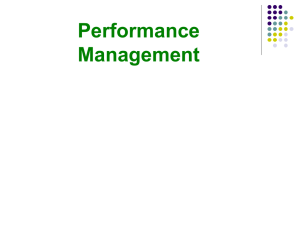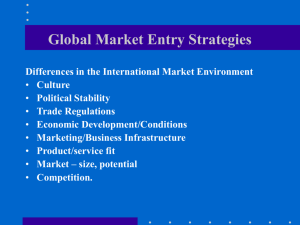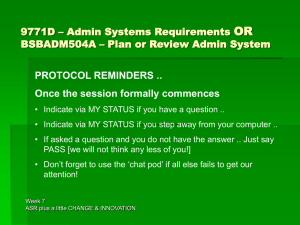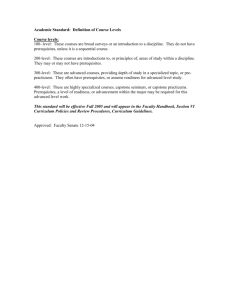P&CM REC 5
advertisement
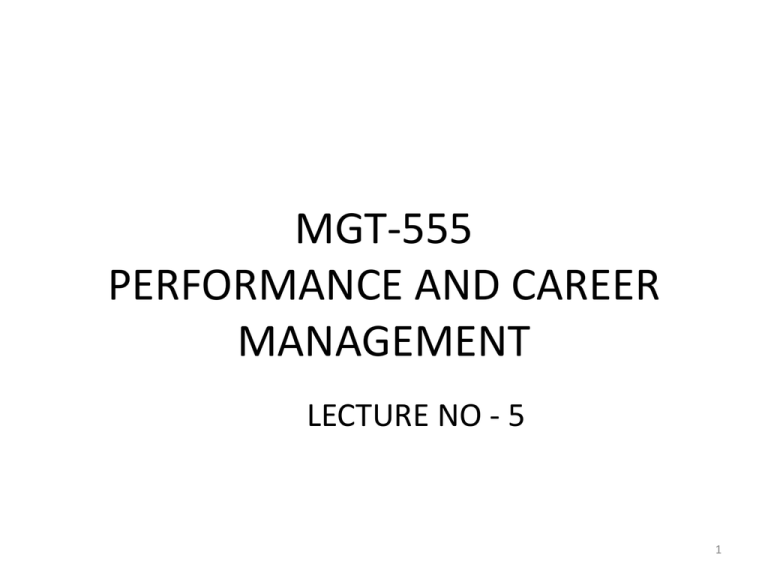
MGT-555 PERFORMANCE AND CAREER MANAGEMENT LECTURE NO - 5 1 RECAP • • • • • • • • • Course Objective Key Learning Outcomes Contents of the Course Structure We have discussed HRM and Strategic HRM(SHRM) in previous lectures, which included following points; 1. Definitions 2. Functions of HRM and SHRM 3. Types of assistance provided by HRD. 4. Challenges faced by Human resource managers. 5. Relationship between Human resource department and other departments. 2 RECAP • 6. Role of Human resource managers in future. • 7. Effect of HRM on organizational performance. • 8. Role of HRM in training and development of employees. • 9. Role of HRM in Performance and career management. • 10. Role of HRM in maintaining competitive pay practices. 3 RECAP • • • • • Understanding Performance management Definitions Case study - PM Systems Case Study - Morgan Stanley Contribution / Advantages of PM System 4 RECAP • Performance management Process – Components of PMP • • • • Performance Execution Performance Assessment Performance review Performance renewal and Re-contracting • Case study 5 Agenda of Today’s Lecture • Performance management Process – Components of Performance Management process • Pre-requisites • Performance Planning – Implementation of Performance Management process 6 Performance management process • “In theory, the Performance Review process can be thought of a positive interaction between a coach and an employee, working together to achieve maximum performance . In reality, its more like finding a dead squirrel in your backyard and realizing the best solution is to fling it into your neighbors roof”. --SCOTT ADAMS 7 Performance management process (Contd.) • Performance management is an ongoing process. • PM does not take place just once a year, it is a continuous process including several components. • These components are closely related to each other, and poor implementation of any of the component has a negative impact on the performance management system as a whole. 8 Prerequisites There are two main prerequisites that are required before a performance management system is implemented • Knowledge of organizations mission and strategic goals and • Knowledge of job in question 9 Prerequisites (Contd.) • PRE-REQUISITE 1 – Knowledge of organizations mission and strategic goals is a result of strategic planning – Strategic planning allows an organization to clearly define it purpose or reason for existing, where it wants to be in future, the goals it wants to achieve and the strategies it will use to attain these goals. 10 Prerequisites (Contd.) – Once the goals for the entire organization has been established, similar goals cascade downward, with departments setting objectives to support the organizations overall mission and objectives. – The cascading continues downward until each employee has a set of goals compatible with those of the organization. 11 Prerequisites (Contd.) • PRE-REQUISITE 2 – The second important pre-requisite before a performance management system is implemented is to understand the job in question. – This is done through job analysis. – Job analysis is a process of determining the key components of a particular job, including activities, tasks, products, services and processes. 12 Prerequisites (Contd.) – A job analysis is a fundamental pre-requisite of any performance management system. – Without a job analysis, it is difficult to understand what constitutes the required duties for a particular job. – If we don’t know what an employee is supposed to do on the job, we won’t know what needs to be evaluated and how to do so. – As a result of the job analysis, we obtain information regarding the tasks carried out and the knowledge, skills and abilities (KSAs) required of a particular job. 13 Prerequisites (Contd.) KSA refers to; • K- (knowledge) – Information needed to perform the work • S- (skills) – Required attributes that are usually acquired by having done the work in the past • A- (ability) – The physical, emotional, intellectual and psychological aptitude to perform work. 14 Prerequisites (Contd.) • The tasks and KSAs needed for the various jobs are typically presented in the form of job description, which summarizes the job duties, needed KSAs and working conditions for a particular job. • CASE- Example– Trailer Truck Driver Job Description. 15 Prerequisites (Case Study) • JOB DESCRIPTION FOR TRAILER TRUCK DRIVER: CIVILIAN PERSONNEL MANAGEMENT SERVICE Operates gasoline or diesel powered truck or truck tractor equipped with two or more driving wheels and with four or more forward speed transmissions, which may include two or more gear ranges. These vehicles are coupled to a trailer or semitrailer by use of a turntable (fifth wheel) or pintle (pivot) hook. Drives over public roads to transport materials, merchandise or equipment. Performs difficult driving tasks such as backing truck to loading platform, turning narrow corners, negotiating narrow passageways, and keeping truck and trailer under control, particularly on wet or icy highways. May assist in loading and unloading truck. May also handle manifest, bills of lading, expense accounts, and other papers pertinent to the shipment. 16 Prerequisites (Contd.) • This job description includes information about; – What tasks are to be performed (e.g operation of a specific type of truck) – Information about the needed • knowledge (e.g manifests, bill of lading) • Skills (e.g keeping truck and trailer under control, particularly in difficult whether conditions) • Abilities (e.g physical and spatial abilities needed to turn narrow corners) 17 Prerequisites (Contd.) • Job Analysis: – Job analysis can be conducted using observation, off-the-shelf questionnaires or interviews. – Alternatively if the job is yet to be created, data can be gathered from individuals responsible for creating the job or those who will supervise the individuals in the new position. 18 19 20 Performance planning • Employees should have thorough knowledge of the performance management system. In fact, at beginning of each performance cycle the supervisor and the employee meet to discuss, and agree upon, what needs to be done and how it should be done. 21 22 Performance planning (Contd.) • The performance planning includes; – a consideration of both results – and behaviors, – as well as a developmental plan. 23 Results • Results refer to what need to be done or the outcomes an employee must produce. • A consideration of results needs to include the key accountabilities, or broad areas of a job for which the employee is responsible for producing results. 24 Results (Contd.) • This information is typically obtained from the job discussion. • A discussion of results also includes specific objectives that the employee will achieve as a part of each accountability. • Objectives are statements of important and measurable outcomes. 25 Results (Contd.) • Finally, discussing results also means discussing performance standards. • A performance standard is a yardstick used to evaluate how well employees have achieved each objective. • Performance standards provide information about acceptable and unacceptable performance. 26 Results (Contd.) • Example:– Consider the job of a university professors. – Two key accountabilities are; • Teaching • Research – An objective for teaching could be “to obtain a student evaluation of teaching performance on a point scale. 27 Results (Contd.) – An objective for research could be ‘to publish two articles in scholarly referred journals per year”. – Performance standard could be “to obtain a student evaluation of teaching performance of atleast 2 on a 4 point scale” – And to publish at least one article in scholarly referred journals per year. • Thus objective is desired level of performance, where as the standard is usually a minimum acceptable level of performance. 28 Behaviors • Its is important to measure results, an exclusive emphasis on results can give a skewed or incomplete picture of employees performance. • Results from a survey indicated that, in addition to sales figure, salespeople would like to be appraised on such behavioral criteria as communications skills and product knowledge. 29 Behaviors (Contd.) • A consideration of behavior includes discussing competencies, which are measurable clusters of KSAs that are critical in determining how results will be achieved. • Examples of competencies are custom service, written or oral communication, creative thinking, and dependability. 30 Behaviors (Contd.) • Example:– Returning to the same example of professor, assume that teaching is done online and numerous technology related problems exist, so that the resulting teaching evaluations are deficient. – This is an example of situation in which behaviors should be given more importance than results. – In this situation the evaluation could include competencies such as online communication skills (e,g in the chat room). 31 Thanks 32

